Table of contents
Use the navigation below to quickly jump to a specific section.
Introduction
Let’s get the confusion out of the way first. There are 7 models in the Lynx series which are divided into two sub-categories.
The most notable difference between the regular and Pro series is that (besides more options to choose from) the Pro series models all utilize a 12µm sensor, while the regular Lynx devices both carry a 17µm sensor.
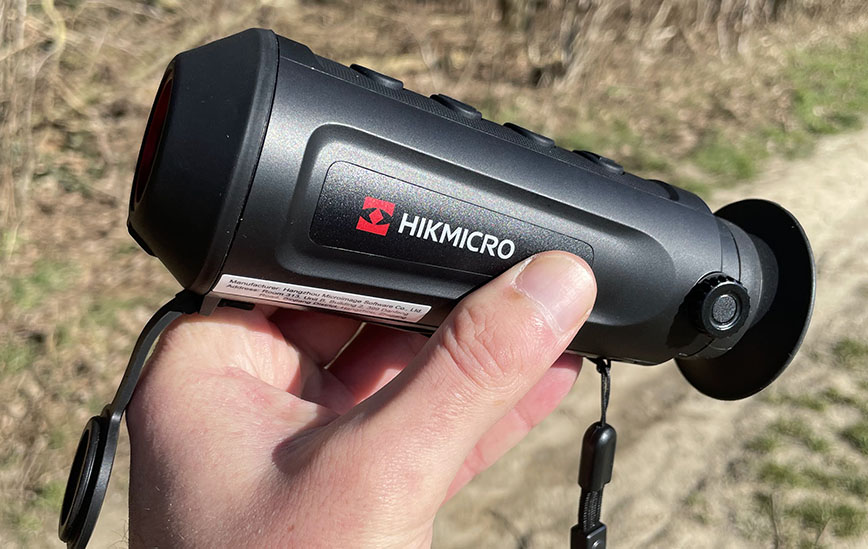 The LH15 is quite compact
The LH15 is quite compact Whether or not a 12µm sensor is better than their 17µm counterpart is a topic of debate but it allows for smaller lenses (thus housings) while keeping the same level of magnification compared to 17µm cameras.
Quick Features
The LH15 is a relatively small monocular packed with all the features you’d expect for a thermal camera in 2022:
- 384 x 288 Sensor (12µm / <35 mK)
- 15mm F/1.0 Lens
- Field of View: 17.5° × 13.1°
- Up to 8x Digital Zoom
- Up to 7.5 hours of battery life
- Weight: 310 grams
- IP67 Rating (Can be submerged for 30 minutes at a depth of up to 1 meter)
- WiFi Streaming
- Stadiametric rangefinder
Not bad right? But specs alone don’t always tell the whole story. Is this camera worth it? Let’s unpack the LH15 and find out together!
Unboxing and first impressions
The HIKMICRO LH15 comes safely packed in a compact box with just enough room to fit its contents. The cut-out foam makes sure the device won’t get damaged easily when the package delivery guy has a bad day (yes it can happen!).
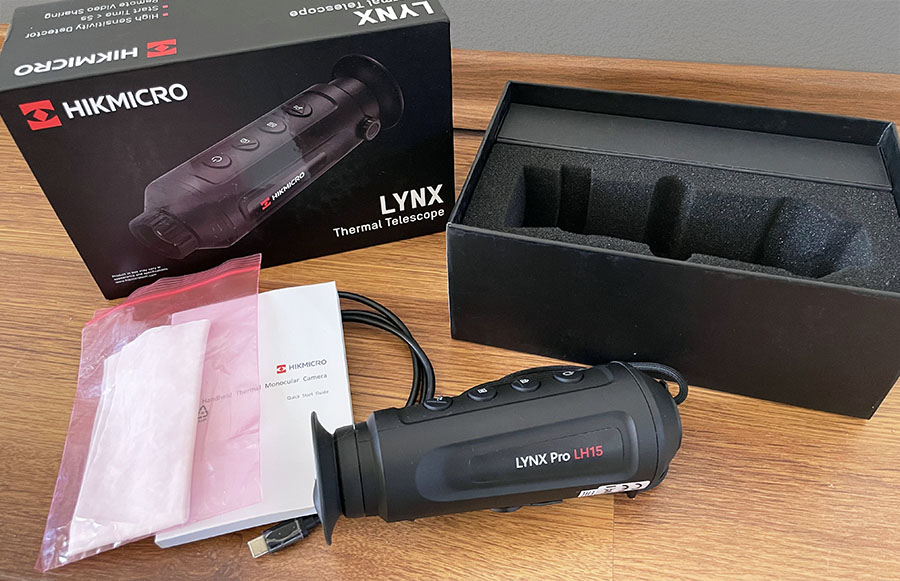 Unboxing the LH15
Unboxing the LH15 Inside you’ll find the following things:
- LH15 Thermal Camera
- User manual
- USB-C Cable
- Lanyard
- Cleaning cloth
There’s not much else to it. You also don’t need anything extra to operate and charge this camera. Some swear at proprietary batteries and chargers but personally I like standard connections for most things, like the standard USB-C cable which comes with it.
The downside of a build-in battery is that it cannot be replaced by yourself and that when it runs out of juice you can’t quickly throw in a new pair of batteries. But in practice faulty batteries are quite rare, especially with HIKMICRO’s quality control. Also, you’ll rarely run out of power with the 7.5 hours of battery life, and when you do just know you can charge and use it at the same time using a power-bank.
The LH15 looks quite compact and lightweight. It’s a familiar looking design which can be traced all the way back to the FLIR Scout series. But that’s a good thing. This kind of design turned out to be a good ‘one size fits all’ story. It’s durable, easy to hold and can fit a wide variety of lenses, sensors and other internal components.
A closer look
Let’s examine the LH15 in a bit more detail and see what we can find out purely based on the externals.
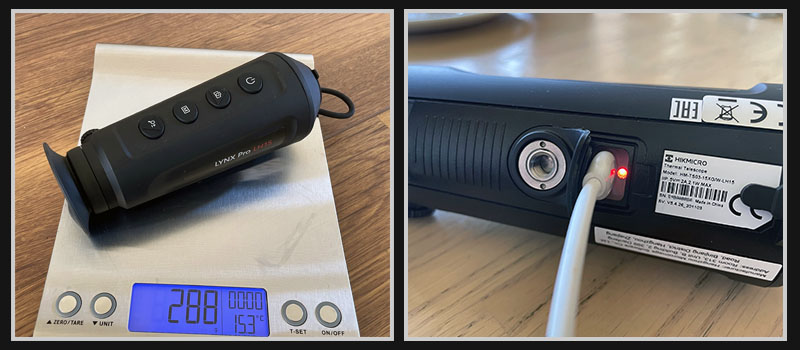 Weight and charging the LH15
Weight and charging the LH15 Normally devices are advertised weighing in lighter than they actually are (often the batteries are not included in the weight specs), but this time I’m pleasantly surprised that it weighs in lighter than advertised. Our scale hits 288 grams as opposed to the 310g advertised.
My clumsy measurements seem to match the advertised 158 × 61 × 57 mm dimensions. Making this a quite small monocular, especially when compared to other cameras like HIKMICRO’s Owl series, which are less friendly for your coat’s pockets.
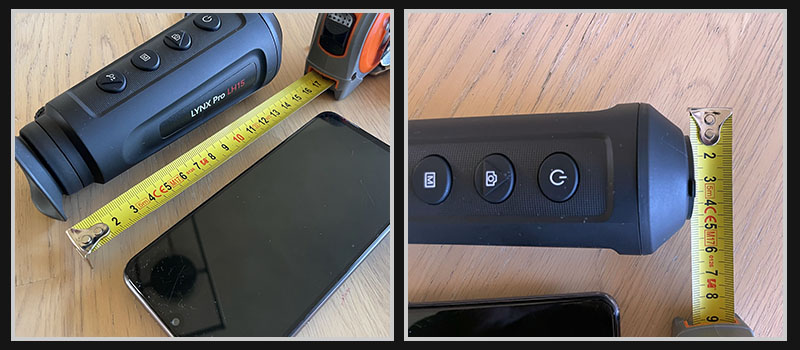 LH15's dimensions
LH15's dimensions While spinning the LH15 in my hands it quickly shows there’s not much to it and this camera is quite user-friendly, even my 6-year-old quickly got the hang of it after a brief instruction.
All navigation can be done single handedly with the 4 buttons on top, charging is done by the USB-C port on the bottom of this device. There’s also a standard 1/4-20 UNC thread to attach the camera to a tripod and a diopter adjustment knob on the left side of the device.
The LH15 has a 15mm fixed focus lens which is sharp enough after about 2 meters onwards, really eliminating the last need to use this camera with two hands. When not in use you can attach the rubber lens-cover to keep the lens safe. Oh, and the lens-cover fits perfectly, this has not always been the case with other devices.
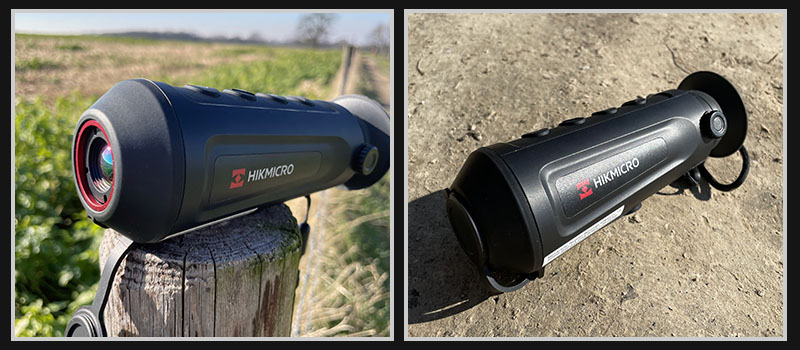 In the field on a sunny day
In the field on a sunny dayBuild Quality
The body of the LH15 made of hard-plastic, mixed with some rubber on the appropriate places. It’s by no means a mil-spec device but since it’s small, lightweight and has a uniform body, I had no fear of it dropping by accident. The lens is tucked away inside the device as well, which keeps it safe in case of the inevitable drop.
Water and electronics are never a good combination, but with an IP67 rating you can be sure the device keeps working, even if you submerge it under water. However, I would not recommend doing exactly that. But, using the LH15 in the rain shouldn’t be a problem if you’re into that.
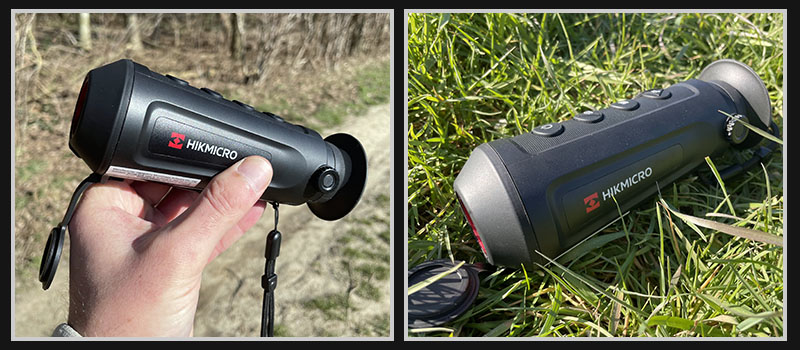 LH15 details
LH15 details For me it’s often just a peace of mind when something is waterproof and submersible, it doesn’t mean I go out and test this theory, especially salt water can do more harm than good. Always rinse it extensively when dropped into the sea.
Image quality and usability
Ok, so the device seems well built, but does it output a decent enough image? First, we must set our expectations. Although the 12µm sensor helps with the base magnification it comes with a 15mm lens, which sits at the smaller end of the spectrum.
 Thermal view
Thermal view This combination gives you a (relatively) large field of view, making it an ideal candidate for a spotting scope, less ideal for identifying animals or objects in the far distance. The 384 x 288 sensor allows (some) room for digital zoom, for the best results I would not suggest going past the 4x zoom.
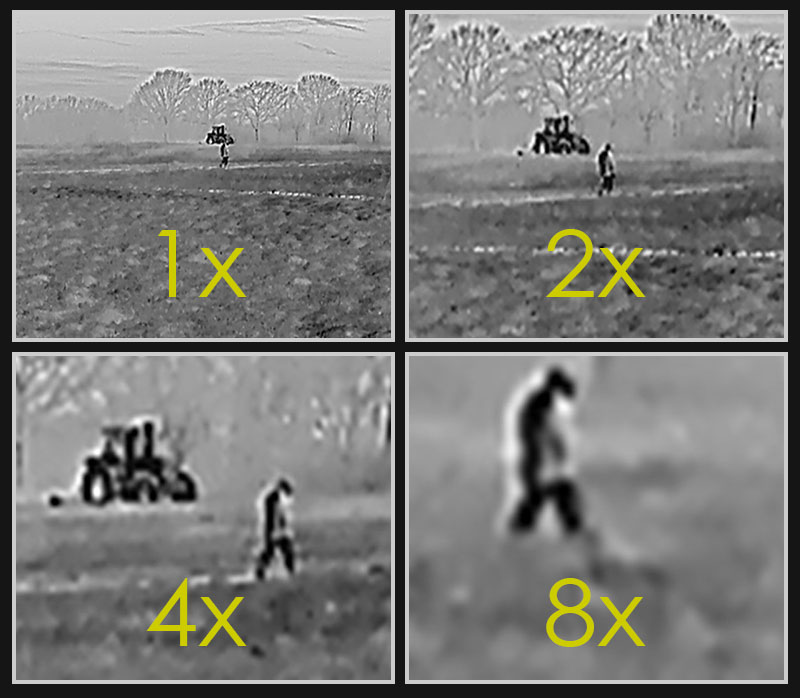 1x 2x 4x 8x Zoom
1x 2x 4x 8x Zoom Wait, didn’t it have 8x digital zoom? Yes, it does, but it doesn’t mean you’ll going to use it a lot. This is not exclusive to the HIKMICRO LH15, this goes for all thermal cameras with a 384 x 288 sensor. There’s just not enough resolution available to build a good picture, image enhancement algorithms can only take you so far.
The LH15 comes equipped with 4 color palettes, which is just right to my taste. Especially with spotting scopes you don’t want to cycle through 16 color palettes to get the best view, while finding out the white/hot or black/hot mode was perfect.
The color palettes are as followed:
- White hot
- Black hot
- Red hot (Highlights are shown in red)
- Fusion (not the be confused with fused thermal cameras)
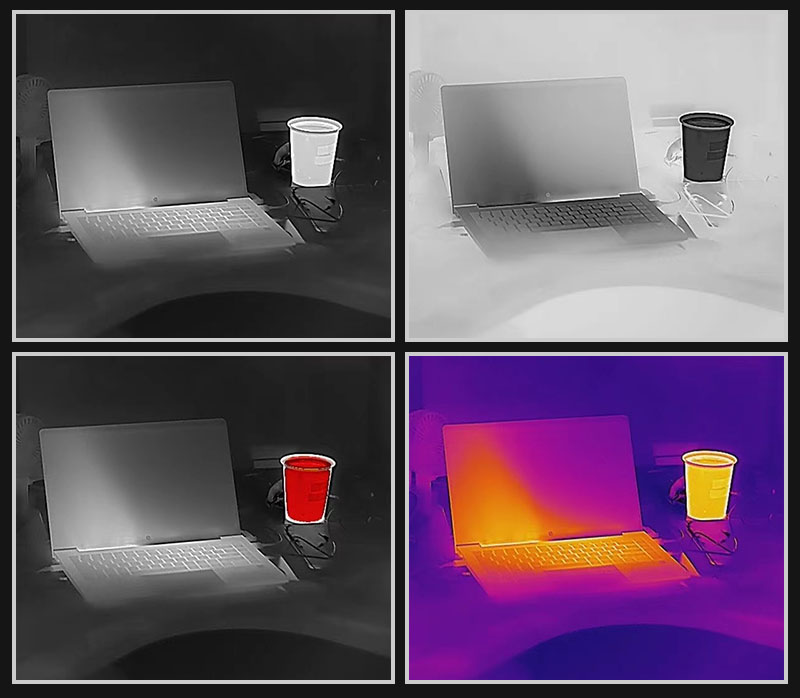 From left to right: White hot, black hot, red hot, fusion
From left to right: White hot, black hot, red hot, fusion What I liked most about using the LH15 is the ease of use. A quick press on the power button makes the camera go in standby mode and I can put it back in my coat’s pocket without a hassle. Whenever I saw something of interest it’s fired up again within seconds.
The NUC (Non-Uniformity Correction) goes automatically and doesn’t make too much noise, although it might be audible in close range (especially at night when there’s little background noise). Luckily it doesn’t need to calibrate too often, and when it does it’s usually at the beginning of your viewing session.
On some cameras I had to play a lot with contrast and brightness to get an optimal image, on this one a bit less so. Both options set somewhere in the middle seemed fine for me for most situations. I think the ease of use also kind of stopped me from tinkering too much with settings. This thermal monocular is really meant to be just picked up and ready for action when you need it.
You can take pictures with a short press on the camera button, a long press starts your video recording. The other two buttons cycle between the different zoom levels (hold for manual FFC) and color palettes.
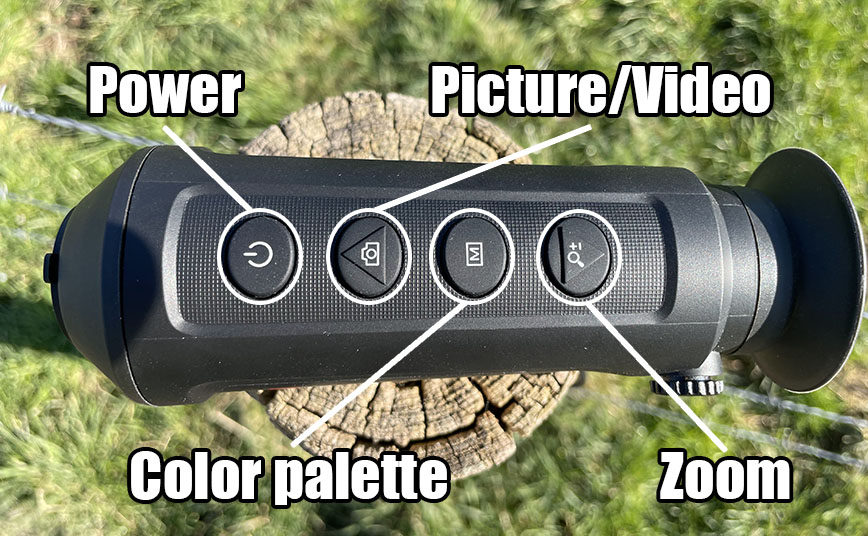 All navigation is done using 4 buttons
All navigation is done using 4 buttons I’m quite pleased with the image quality in general. It didn’t blow me out of the water in terms of performance, nor did I expect it to. But for the price it’s really a solid device which makes for a reliable spotter scope you can take with you on any (hunting) trip, or just leave it in your car for when you need it.
The LCOS display, while large enough for a pleasant viewing experience lacks some contrast if you directly compare it with an OLED screen. I didn’t notice any ghosting in particular when quickly panning a scene, that’s something users often complain about with this type of display.
 Random images
Random images After you returned from your trip, images and videos are downloaded via the all new HIKMICRO Sight App (Available for iOS and Android). If you prefer connecting it to your computer and transfer files over USB that's of course still possible. There's no need to install any proprietary drivers to be able to do so.
Extra features
While the LH15 is meant to be user friendly, it doesn’t mean it’s a basic device at heart. You do have the options to change a lot of settings and explore more advanced functions.
Next to the contrast and brightness settings which we mentioned earlier you also have access to a stadiametric rangefinder, which measures objects based on predefined reference heights. Of course this can’t beat a LRF (Laser Range Finder) but it might be useful in some scenarios, personally I never felt the need for one.
Connect with HIKMICRO
Follow HIKMICRO on social media to stay updated on news, product releases and firmware upgrades.